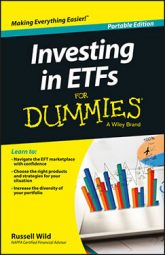The broadest fixed income ETFs are all-around good bets, especially for more modest sized portfolios. Note that these bonds use a total (taxable) bond market approach, which means about two-thirds government bonds and one-third corporate (no municipal). These funds also make the most sense for investors with lots of room in their tax-advantaged retirement accounts.
If you have to stick your bonds in a taxable account, you're probably better off separating your Treasury bonds and your corporate bonds. Reason: You get a tax break on Treasury bond interest, in that you do not have to pay state income tax. If, however, your Treasury bonds are buried in an aggregate fund, such as these, you have to pay state income tax on the interest.
Vanguard Total Bond Market (BND)
Indexed to: The Barclays Capital U.S. Aggregate Float Adjusted Index, which is made up of about 8,000 bonds, two-thirds of which are U.S. government bonds and one-third of which are higher quality corporate bonds. The average credit quality indicates that there is very little chance any of the bonds in the index will default. (Even if a few did, with about 8,000 holdings, the entire apple cart wouldn't turn over.)
Expense ratio: 0.08 percent
Current yield: 2.0 percent
Average credit quality: AA
Average weighted maturity: 7.7 years
Review: How can you go wrong with the world's largest provider of index funds tracking the entire bond market for you and charging you only 0.08 percent (that's 8 percent of 1 percent)? BND makes an excellent building block in smaller portfolios or for any investor seeking the ultimate in simplicity, especially where there's lots of room in tax-advantaged accounts. For larger portfolios, however, where you can afford to mix and match other bond funds of different flavors, the need for BND becomes less clear.
iShares Barclays Aggregate Bond Fund (AGG)
Indexed to: The Barclays Capital U.S. Aggregate Bond Index, which tracks the performance of the total U.S. investment grade bond market, including both government bonds and the highest quality corporate bonds
Expense ratio: 0.08 percent
Current yield: 1.9 percent
Average credit quality: AA
Average weighted maturity: 7.6 years
Review: AGG is a good fund, without any great differences from BND, although it uses a smaller sampling of bonds. Even so, 3,600 bonds (versus BND's 16,400) still offer darned good diversification.
Vanguard Short-Term Bond (BSV)
Indexed to: The Barclays Capital U.S.1–5 Year Government/Credit Float Adjusted Index, which is about 2,300 bonds, two-thirds of which are short-term U.S. government and one-third of which are higher quality corporate bonds, also of short-term maturity
Expense ratio: 0.10 percent
Current yield: 1.1 percent
Average credit quality: AA
Average weighted maturity: 2.8 years
Review: In normal times, most investors should stick with intermediate-term bonds and forget about short-term bonds that typically yield considerably less. Recently, however, with interest rates so low, low, low, you might want to lean your portfolio more to the short-term. Reason: When interest rates pop, as eventually they will, longer-term bonds are going to suffer. For more conservative investors especially, BSV may warrant half of your allocation to U.S. bonds. When interest rates start to climb back up to historical norms, you may then want to move some or all of your BSV assets to BND.

